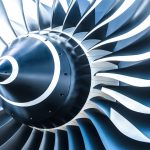
Aircraft manufacturers sponsor research because they need stress data to improve computer models of the lifetime of their parts.
Source: Canadian Neutron Beam Centre (CNBC)
Contact: cnbc@cnl.ca
Image: Bombardier
 Increasing the useful life of aircraft parts can reduce maintenance costs, which can be significant considering that any change to an aircraft must be carefully controlled to assure regulators of passenger safety. Thus, major aircraft manufacturers sponsor research at universities to generate a better understanding of materials, which can help the industry to develop parts with longer lifetimes.
Increasing the useful life of aircraft parts can reduce maintenance costs, which can be significant considering that any change to an aircraft must be carefully controlled to assure regulators of passenger safety. Thus, major aircraft manufacturers sponsor research at universities to generate a better understanding of materials, which can help the industry to develop parts with longer lifetimes.
One such manufacturer sponsored a research team led by Professor Michael Fitzpatrick of Coventry University in the United Kingdom. This team examined the effectiveness of surface treatments used to increase the lifetimes of parts like the aluminum skin on airplane wings and fuselages. The team also wanted to see whether a computer model could predict how these surface treatments would create stress in aluminum specimens, since such stress affects a part’s fatigue life (i.e., how long a part can withstand varying pressures over many flights).
A big reason I came to the CNBC was I could get time on a beamline faster there than at any other diffraction facility in the world.
Because getting accurate stress measurements is crucial, Stefano Coratella, a graduate student in Prof. Fitzpatrick’s team, accessed several major neutron beam and x‑ray facilities around the world to gather data for various portions of the research. Coratella came to the Canadian Neutron Beam Centre to examine how combining two different surface treatments, known as shot peening and laser shock peening, would affect stress. Used individually, these treatments introduce ‘compressive’ stress, which helps to make the material last longer. The latter treatment is a newer technique that has been used successfully to improve fatigue life for gas turbine engine compressors and fan blades.
The aircraft manufacturer that sponsored the research was interested in knowing whether applying both methods could further enhance the positive effects of each individual technique.
“A big reason I came to the CNBC was I could get time on a beamline faster there than at any other diffraction facility in the world,” said Coratella.
Using specimens provided by the aircraft manufacturer, Coratella was able to use the stress data collected at the CNBC to demonstrate that the computer model was more effective at predicting the stress induced by the laser shock peening of an aluminum sample than it was at predicting the stress induced when shot peening was applied after laser shock peening. More research is required to understand why that is the case, and also so that the computer model can be improved.

An aluminum specimen with a milled notch and surface treatments ready for examination with neutron beams at the CNBC
